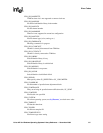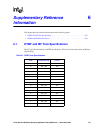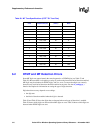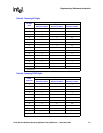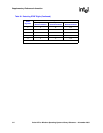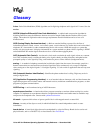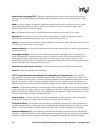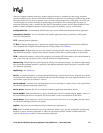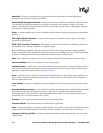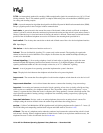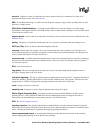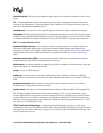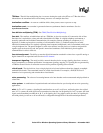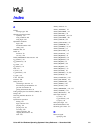
544 Voice API for Windows Operating Systems Library Reference — November 2003
board locator technology (BLT): Operates in conjunction with a rotary switch to determine and set non-
conflicting slot and IRQ interrupt-level parameters, thus eliminating the need to set confusing jumpers or DIP
switches.
buffer: A block of memory or temporary storage device that holds data until it can be processed. It is used to
compensate for the difference in the rate of the flow of information (or time occurrence of events) when
transmitting data from one device to another.
bus: An electronic path that allows communication between multiple points or devices in a system.
busy device: A device that has one of the following characteristics: is stopped, being configured, has a
multitasking or non-multitasking function active on it, or I/O function active on it.
cadence: A pattern of tones and silence intervals generated by a given audio signal. The pattern can be classified
as a single ring, a double ring, or a busy signal.
cadence detection: A voice driver feature that analyzes the audio signal on the line to detect a repeating pattern
of sound and silence.
call progress analysis: A process used to automatically determine what happens after an outgoing call is
dialed. On DM3 boards, a further distinction is made. Call progress refers to activity that occurs before a call is
connected (pre-connect), such as busy or ringback. Call analysis refers to activity that occurs after a call is
connected (post-connect), such as voice detection and answering machine detection. The term call progress analysis
is used to encompass both call progress and call analysis.
call status transition event functions: A class of functions that set and monitor events on devices.
caller ID: calling party identification information.
CCITT (Comite Consultatif Internationale de Telegraphique et Telephonique): One of the four
permanent parts of the International Telecommunications Union, a United Nations agency based in Geneva. The
CCITT is divided into three sections: 1. Study Groups set up standards for telecommunications equipment, systems,
networks, and services. 2. Plan Committees develop general plans for the evolution of networks and services. 3.
Specialized Autonomous Groups produce handbooks, strategies, and case studies to support developing countries.
channel: 1. When used in reference to an Intel® analog expansion board, an audio path, or the activity happening
on that audio path (for example, when you say the channel goes off-hook). 2. When used in reference to an Intel®
digital expansion board, a data path, or the activity happening on that data path. 3. When used in reference to a bus,
an electrical circuit carrying control information and data.
channel device: A channel-level object that can be manipulated by a physical library, such as an individual
telephone line connection. A channel is also a subdevice of a board. See also subdevice.
CO (Central Office): A local phone network exchange, the telephone company facility where subscriber lines
are linked, through switches, to other subscriber lines (including local and long distance lines). The term “Central
Office” is used in North America. The rest of the world calls it “PTT”, for Post, Telephone, and Telegraph.
computer telephony (CT): The extension of computer-based intelligence and processing over the telephone
network to a telephone. Sometimes called computer-telephony integration (CTI), it lets you interact with computer
databases or applications from a telephone, and enables computer-based applications to access the telephone




